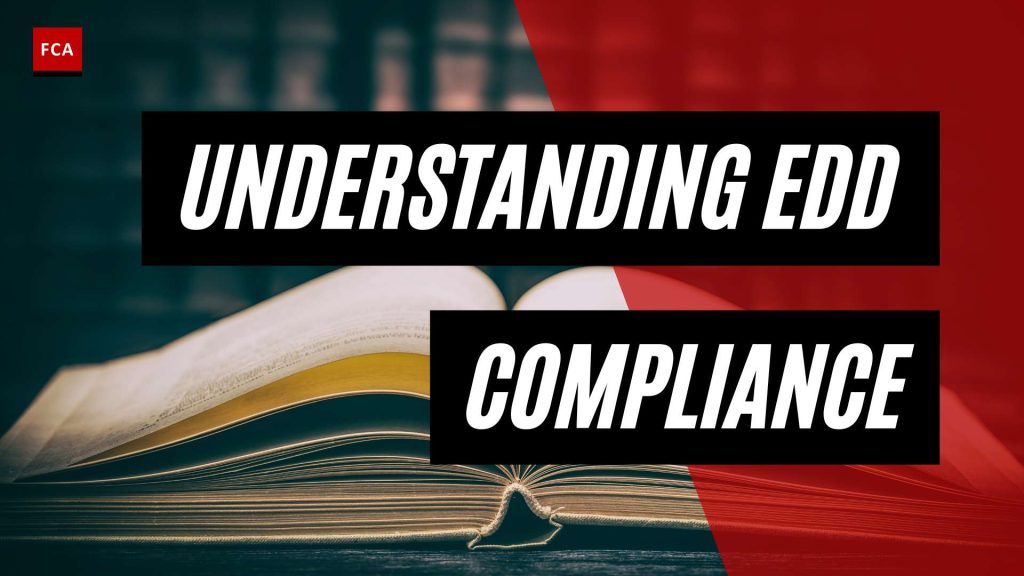Understanding Enhanced Due Diligence
To effectively prevent financial crimes such as money laundering and terrorist financing, professionals working in compliance, risk management, and anti-financial crime must understand the concept and importance of Enhanced Due Diligence (EDD).
Definition and Importance of EDD
Enhanced Due Diligence (EDD) is a comprehensive risk assessment process designed to gather and analyze information about high-risk customers or business relationships. This process goes beyond standard due diligence procedures, offering a deeper level of scrutiny.
EDD typically involves verifying the identity of clients or potential clients, assessing their risk level, scrutinizing their transaction patterns, and analyzing their source of funds. It is instrumental in identifying politically exposed persons (PEPs) and individuals with high-risk profiles, thus helping to mitigate financial crime risks.
In essence, EDD is a critical component of a risk-based approach to EDD and forms an integral part of EDD regulations and requirements. It ensures compliance with global and local regulations, protects businesses from financial and reputational damage, and contributes to the global fight against financial crime.
Difference Between EDD and CDD
Enhanced Due Diligence (EDD) and Customer Due Diligence (CDD) are both vital components of the Know Your Customer (KYC) process. However, there is a significant difference in their scope of application. While CDD is a standard process applied to all customers, EDD comes into play specifically for high-risk customers requiring additional scrutiny.
The KYC process involves customer identity verification and continuous monitoring, which are essential elements of both CDD and EDD. However, EDD takes these steps further by providing a more detailed risk-based approach that includes additional measures to scrutinize and monitor high-risk customers. This additional scrutiny helps detect potential money laundering activities and other financial crimes.
In the context of a risk-based approach to EDD, this differentiation is crucial. It ensures that resources are appropriately allocated, focusing the most intensive scrutiny on the highest-risk customers. This not only improves efficiency but also enhances the effectiveness of anti-money laundering and anti-financial crime efforts.
Understanding the distinction between EDD and CDD is critical for compliance professionals. It enables them to better navigate the complexities of EDD procedures and methodologies, ensuring efficient and effective compliance with regulatory requirements.
Who Requires Enhanced Due Diligence?
Enhanced Due Diligence (EDD) is an important step in the risk management process. It helps in identifying and scrutinizing certain individuals who pose significant risks to an organization. This includes high-risk customers and Politically Exposed Persons (PEPs).
Identifying High-Risk Customers
High-risk customers are those who have the potential to threaten a company and its operations by engaging in fraudulent activities, compliance concerns, or cybersecurity breaches. They are identified based on certain attributes and can include individuals from high-risk jurisdictions, those with complex ownership structures, or those involved in industries that are prone to corruption or illicit activities.
These customers require a higher level of scrutiny compared to regular customers. EDD helps in understanding their transaction patterns, source of funds, and risk level. For more information on this, you can refer to our article on EDD for High-Risk Customers.
Politically Exposed Persons (PEPs)
Politically Exposed Persons, or PEPs, are individuals who hold a prominent public position or function. Due to their position, they are considered high-risk customers as they have a greater potential to be involved in bribery or corruption.
EDD is crucial in identifying and monitoring PEPs. It involves understanding their source of funds, their business relationships, and their political affiliations. This helps in mitigating the risk of being associated with money laundering activities or other financial crimes.
It’s important to note that not all PEPs are involved in illicit activities. However, due to their high-risk status, they warrant a more detailed examination as part of the EDD process. For more on this, read our guide on EDD for PEPs.
In conclusion, EDD is a crucial process that goes beyond the standard due diligence procedures. It involves a deeper level of scrutiny of high-risk customers and PEPs, helping organizations mitigate financial crime risks effectively. For more insights on the various aspects of EDD, refer to our articles on EDD regulations and requirements and risk-based approach to EDD.
Implementing Enhanced Due Diligence
The process of implementing Enhanced Due Diligence (EDD) requires a strategic and systematic approach. EDD is a comprehensive assessment designed to gather and analyze information about high-risk customers or business relationships to identify and mitigate potential financial crimes like money laundering and terrorist financing. Here are the key steps and the role of Know Your Customer (KYC) in this process.
EDD Checklist: Key Steps
To ensure effective EDD implementation, compliance professionals should follow a checklist of key steps:
-
Risk Assessment: Begin by assessing the risk level of the client or business relationship. Consider factors such as the type of business, geographical location, nature of transactions, and any political exposure.
-
Identity Verification: Verify the identity of the client or potential client. This may involve checking official identification documents, company registration documents, and other relevant information.
-
Transaction Monitoring: Monitor the client’s transaction patterns to identify any suspicious activities. This includes regular reviews of transaction history and ongoing monitoring of account activities.
-
Source of Funds Check: Investigate the source of the client’s funds to ensure they are legitimate. This can help identify any links to criminal activities such as money laundering or fraud.
-
Ongoing Review: Regularly review the client’s risk profile and update the EDD process accordingly. Any changes in the client’s behavior or risk level should trigger a review of the EDD measures in place.
Understanding these steps is crucial for compliance professionals working on EDD for financial institutions and in implementing EDD procedures and methodologies.
Role of Know Your Customer (KYC)
The Know Your Customer (KYC) process plays a significant role in the implementation of EDD. As an extension of the KYC process, EDD offers a more detailed risk-based approach that includes additional measures to scrutinize and monitor high-risk customers to detect potential money laundering activities (Idenfy).
KYC checks involve customer identity verification and continuous monitoring. These checks are not only a crucial part of the EDD process but also a regulatory requirement. Regulated entities are mandated to have a clear understanding of their business relationships, with businesses needing to fulfill CDD and EDD requirements through engaging in KYC checks (Idenfy).
To support these processes, there are EDD software and tools available that can automate many tasks and improve the accuracy and efficiency of EDD and KYC checks.
Implementing Enhanced Due Diligence is a critical task for compliance professionals, and it’s essential to stay updated on EDD regulations and requirements. It’s also beneficial to undergo EDD training and certification to ensure a thorough understanding of the EDD process and its best practices.
EDD in Banking Sector
The banking sector plays a pivotal role in the implementation of Enhanced Due Diligence (EDD) measures. These procedures are designed to authenticate clients’ identities and assess the money laundering risk each customer poses, requiring significantly more details than standard Customer Due Diligence (CDD) to minimize associated risks.
EDD Procedures in Banking
EDD procedures in banking usually encompass several key steps. Firstly, it includes understanding the customer’s profile, the nature and purpose of the business relationship, and the beneficial owner. Banks also need to assess and document risk and conduct ongoing monitoring of the business relationship.
In addition, banks should seek additional credentials, analyze the source and ultimate beneficial ownership of funds, track ongoing transactions, review adverse media, conduct on-site visits to physical addresses, draft investigative report papers, and develop an ongoing risk-based monitoring strategy. More information on this can be found in our guide on EDD procedures and methodologies.
Regulatory Compliance and EDD
Regulatory compliance is a critical aspect of EDD. The Financial Action Task Force (FATF) recommends incorporating EDD measures for business relationships and transactions with both natural and legal persons, including financial institutions. This includes implementing Know Your Customer (KYC) measures, Anti-Money Laundering (AML) guidelines, and Customer Due Diligence (CDD) processes.
Regulated entities, including banks, are mandated to have a clear understanding of their business relationships. Businesses need to fulfill CDD and EDD requirements through engaging in KYC checks, which involve customer identity verification and continuous monitoring.
Banks, as part of their EDD process, should be aware of the EDD regulations and requirements and ensure they are in full compliance to avoid regulatory penalties and sanctions. For those interested in enhancing their understanding of EDD, our EDD training and certification can provide a comprehensive overview of the subject matter.
Technology and EDD
The advent of technological advancements has paved the way for more efficient and accurate Enhanced Due Diligence (EDD) processes. This includes the automation of EDD procedures, as well as the use of Artificial Intelligence and Machine Learning to refine risk assessments.
Automating EDD Processes
The automation of EDD processes is becoming increasingly important for compliance professionals. This technology-driven approach enables organizations to streamline their measures, improve risk assessments, and reduce the likelihood of compliance violations.
EDD automation involves several key processes, including the verification of documents such as business registration and proof of income across 200+ countries and regions. It also involves conducting investigations and resolving cases more efficiently with a configurable case management hub, thereby exposing an individual’s full identity record to meet regulatory compliance.
In addition, automation allows organizations to verify ownership through methods such as 2FA and phone carrier matches, and to verify mobile driver’s licenses securely from digital wallets. It can also automatically and securely verify passports via NFC chip as part of their EDD processes.
For more on automating EDD processes with advanced tools and software, explore our guide on EDD software and tools.
Role of AI and Machine Learning
Artificial Intelligence (AI) and Machine Learning (ML) are playing an increasingly significant role in the automation of EDD processes. These technologies enhance risk assessments and improve efficiency by leveraging advanced risk intelligence algorithms and extensive data sources.
AI and ML technologies are capable of automating and customizing media checks across 400+ million news articles to uncover and block fraud rings. They also leverage link analysis to connect risky accounts and enhance understanding of risk with device fingerprints, behavioral signals, and more (Persona).
Moreover, these technologies can also help in screening across global sanction, warning, and PEP lists, automating negative news checks, and enriching a user’s profile with their social media handles to build trust and safety into every user touchpoint (Persona).
The role of AI and ML in EDD is a rapidly evolving field, with new applications and methodologies continually being developed. Stay updated with our latest articles on EDD procedures and methodologies and EDD training and certification for the most recent information.
In conclusion, technology has revolutionized the EDD process, making it more efficient, accurate, and reliable. As regulatory environments become more complex, technological solutions like automation, AI, and ML will continue to play a key role in ensuring compliance and mitigating risks.
Risks of Inadequate EDD
Failure to properly implement Enhanced Due Diligence (EDD) can have significant implications for organizations, particularly those in the financial sector. The risks of inadequate EDD range from financial and regulatory penalties to reputation and operational risks.
Financial and Regulatory Penalties
Regulators worldwide have imposed nearly US$38.47 billion in fines on financial institutions since 2000. This amount includes $21.47 billion for Anti-Money Laundering (AML) violations and $16.9 billion for sanctions-related violations (Jumio). These penalties highlight the serious consequences of failing to comply with EDD regulations and requirements.
Companies are required to use EDD procedures when dealing with high-risk customers, suspicious transactions, politically exposed persons (PEPs), individuals from high-risk or sanctioned countries, or situations with an increased risk of money laundering. Failure to conduct proper EDD can result in significant penalties.
For more information on EDD regulations and requirements, check out our article on edd regulations and requirements.
Reputation and Operational Risks
In addition to financial penalties, inadequate EDD can also result in significant reputational damage. In today’s digital age, news of AML and sanctions-related violations can spread quickly, damaging an organization’s reputation and eroding customer trust.
Furthermore, regulatory scrutiny following compliance failures can disrupt operations, leading to increased costs and potential loss of business. It emphasizes why a risk-based approach to EDD is essential for organizations dealing with high-risk customers and operating in high-risk sectors or jurisdictions.
For more insights into EDD best practices and how to mitigate these risks, check out our articles on edd procedures and methodologies and edd software and tools.
In conclusion, EDD plays a crucial role in helping institutions comply with AML and counter-terrorism financing (CTF) regulations. It’s part of their efforts to mitigate financial crime risks. Therefore, maintaining robust EDD procedures is not only a regulatory requirement but also a crucial business imperative for ensuring operational resilience and maintaining a good reputation in the market.









